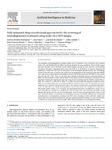Fully automatic deep convolutional approaches for the screening of neurodegeneratives diseases using multi-view OCT images

Use este enlace para citar
http://hdl.handle.net/2183/39954
Excepto si se señala otra cosa, la licencia del ítem se describe como Atribución-NoComercial-SinDerivadas 3.0 España
Colecciones
- Investigación (FIC) [1683]
Metadatos
Mostrar el registro completo del ítemTítulo
Fully automatic deep convolutional approaches for the screening of neurodegeneratives diseases using multi-view OCT imagesAutor(es)
Fecha
2024-12Cita bibliográfica
L. Álvarez-Rodríguez, A. Pueyo, J. de Moura et al., Fully automatic deep convolutional approaches for the screening of neurodegeneratives diseases using multi-view OCT images. Artificial Intelligence In Medicine (2024), doi: https://doi.org/10.1016/j.artmed.2024.103006
Resumen
[Abstract]: The prevalence of neurodegenerative diseases (NDDs) such as Alzheimer’s (AD), Parkinson’s (PD), Essential tremor (ET), and Multiple Sclerosis (MS) is increasing alongside the aging population. Recent studies suggest that these disorders can be identified through retinal imaging, allowing for early detection and monitoring via Optical Coherence Tomography (OCT) scans. This study is at the forefront of research, pioneering the application of multi-view OCT and 3D information to the neurological diseases domain. Our methodology consists of two main steps. In the first one, we focus on the segmentation of the retinal nerve fiber layer (RNFL) and a class layer grouping between the ganglion cell layer and Bruch’s membrane (GCL-BM) in both macular and optic disc OCT scans. These are the areas where changes in thickness serve as a potential indicator of NDDs. The second phase is to select patients based on information about the retinal layers. We explore how the integration of both views (macula and optic disc) improves each screening scenario: Healthy Controls (HC) vs. NDD, AD vs. NDD, ET vs. NDD, MS vs. NDD, PD vs. NDD, and a final multi-class approach considering all four NDDs. For the segmentation task, we obtained satisfactory results for both 2D and 3D approaches in macular segmentation, in which 3D performed better due to the inclusion of depth and cross-sectional information. As for the optic disc view, transfer learning did not improve the metrics over training from scratch, but it did provide a faster training. As for screening, 3D computational biomarkers provided better results than 2D ones, and multi-view methods were usually better than the single-view ones. Regarding separability among diseases, MS and PD were the ones that provided better results in their screening approaches, being also the most represented classes. In conclusion, our methodology has been successfully validated with an extensive experimentation of configurations, techniques and OCT views, becoming the first multi-view analysis that merges data from both macula-centered and optic disc-centered perspectives. Besides, it is also the first effort to examine key retinal layers across four major NDDs within the framework of pathological screening.
Palabras clave
Neurodegenerative diseases
OCT
Multi-view
Retinal layers
Deep learning
Screening
Retinal layers segmentation
OCT
Multi-view
Retinal layers
Deep learning
Screening
Retinal layers segmentation
Versión del editor
Derechos
Atribución-NoComercial-SinDerivadas 3.0 España






